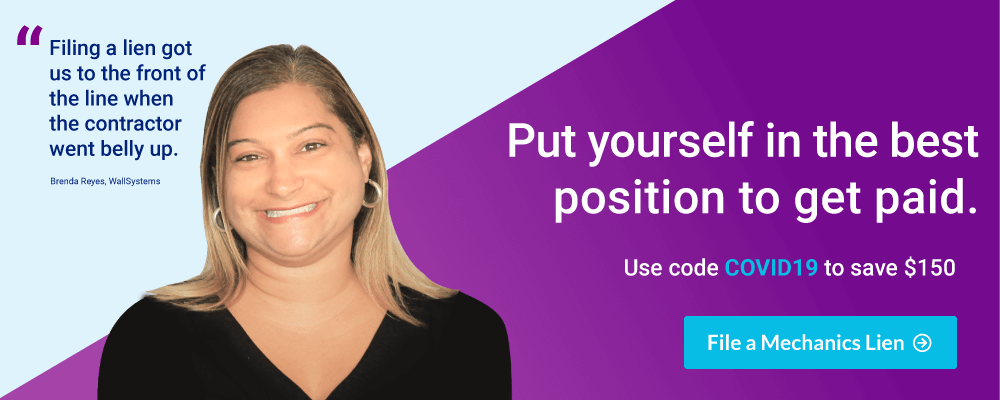
The results of the 2020 National Construction Payment Survey are in, and the data shows how badly the current construction payment process is working. That survey also shows that as many 40% of contractors don’t use the mechanics lien process to resolve slow payment problems on their projects. In an industry where cash flow is crucial to survival, why aren’t contractors using the tools that get them paid faster?
Lien-o-phobia: Why are contractors so afraid to fight slow payments?
One aspect of being a good tradesman is knowing how and when to use the necessary tools for a job.
The mechanics lien is a payment collection tool that every contractor should know when and how to use correctly. In almost state, sending preliminary notice is part of protecting a contractor’s right to file a mechanics lien claim. These documents provide enormous payment protection for contractors and material suppliers.
Yet, according to the survey, only about 30% of contractors regularly send preliminary notices. Of course, some states offer an easier process and more substantial protection than others. But even where they aren’t required required, preliminary notices are still shown to help speed up contractor payments.
Using your tools: 3 steps for contractors to cure slow payment
Many contractors don’t get paid on time because they have what I like to call lien-o-phobia: an aversion to filing payment claims even when you haven’t been paid.
Luckily, there is a 3-step process that cures most cases of this common contractor ailment.
Step 1. Review the requirements and deadlines for preliminary notices and mechanics liens for your specific state. Choose your state on this map to view lien rules and requirements.
Step 2. Download notice & lien forms to your computer.
Get free preliminary notice forms for every state here.
And get free mechanics lien forms for every state here.
Step 3. Immediately start submitting prelims on every project, following the state requirements.
Just those three steps alone are often enough to repair a contractor’s slow payment problem. Of course, some payment delays may get to the point where you need to send a notice of intent (NOI) or file a mechanics lien. But because you’ve taken the first step to protecting your lien rights, you’ll be protected and able to follow through.
Debunking common mechanics lien myths
Even though the cure for slow payment is readily available and proven to work, many contractors still refuse treatment. Two common myths are the main reasons why contractors don’t adopt a mechanics lien policy.
Myth 1: Protecting my lien rights will affect my business relationships.
In the survey, 1 in 3 contractors said they don’t file liens because they’re afraid they’ll lose a customer.
I have never understood this mindset. By following your state’s lien process, you are complying with state law. Most people and companies would prefer to work with a law-abiding individual or business, as it means fewer potential problems down the road for everyone involved in the project.
Regular use of preliminary notices actually improves communication with your customers.
Business is business. Contractors have to be diligent in protecting their cash flow – and their employees – at all times. Liens don’t have to affect business relationships in a negative way. Regular use of prelims actually improves communication with your customers, and provides the most effective defense against late or non-payment issues on a project.
If a customer gets upset when you protect your future receivables, what does that say about his/her company?
For a property owner or GC that plans to pay you on time, then the prelim will not have an adverse effect at all.
An owner or contractor who doesn’t plan on paying on time – or at all – will not be happy to see your preliminary notice. Why are you so concerned about what a non-paying customer thinks?
Myth 2: Filing prelims and liens take too much time and energy.
The second excuse against treatment that I hear is that the mechanics lien process is a complete time-drain. Contractors complain that it’s just “something else for my to-do list.” Yet another argument I don’t understand. You don’t want to add something to your to-do list that helps you get paid – and reduces the amount of time you spend chasing down late payments?
Thanks to the internet, you can quickly calculate your notice and lien deadlines, complete the paperwork, and even arrange for delivery from your computer or phone. You can be done with the entire prelim process for a project in as little as 5 minutes.
Then, if the wheels come off the payment train, filing the lien paperwork will require another 30 minutes or so of your time. (Or even less, if you use a lien filing service to handle the lien claim.)
So, you invest in an hour’s worth of time to protect your payments and retainage for a project. Considering that job might be $5K, $500K, or even $5 million, an hour of your time spent filing prelims could save you from spending much more time chasing your payments.
So much for the time-drain excuse.
A new payment mindset: Notices & liens are part of the territory
I always compare the lien process to the collection of sales tax. Nobody wants to spend that extra money, but sales tax is uniform and consistent, and anyone spending money is probably paying the required sales tax.
Sales tax is a necessary component of (almost) every purchase cycle. So, shift your mindset to the fact that preliminary notices are an essential component of your construction payment cycle. Watch your fear of liens disappear for good – and make late payments a thing of the past.
Slow payment & fear cost contractors money
You are essentially providing interest-free financing for your customer to use at their discretion – and at your expense. Let’s say you want to borrow $10K from the bank. The loan is approved, and you begin paying the interest back as part of each payment you make, from day one.
Why would your customer ever get a loan from the bank when you allow them to use your money for free?
Now let’s say a contractor owes you $10K on work your company provided last month. Considering the 83-day average for receiving construction payments:
- Did he pay you interest for using your money to pay his bills?
- Will he reimburse your company for the fast-pay discount you lost at the supply house?
- Is he covering the late fees charged to your other accounts, because he is paying you so late?
The answer to these questions is always a huge NO!
Of course, they don’t and won’t, and why would they ever get a loan from the bank when you allow them to use your money for free?
These are just a couple of the benefits to effectively filing prelims and mechanic liens. I choose these points today because they impact your construction company’s cash flow, profitability, and bottom line.
Contractors have the tools to fix slow payment
The good news is that contractors already have all of the tools they need to speed up payment, build a stronger business, and protect their company’s income.
- Get paid first: Those who use preliminary notices are almost guaranteed to get paid before contractors who don’t submit prelims.
- Be professional: Notifying the owner/lender/GC that your company is providing work, and expecting to be paid, shows that you are a professional who follows the state law.
- Take a stand: Mechanics liens are very hard to challenge, especially when your company has filed the prelim and lien correctly.



